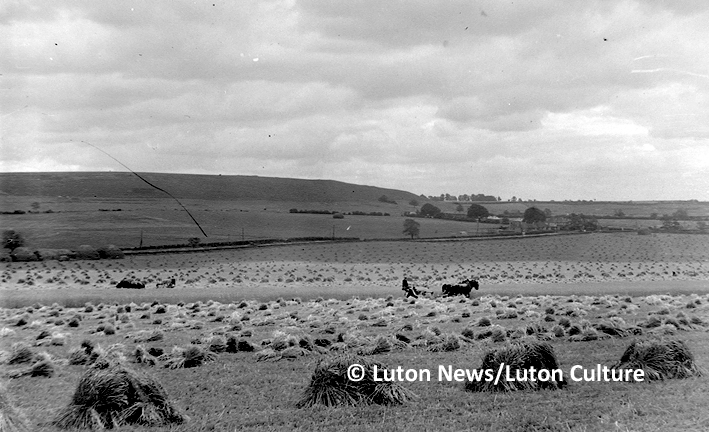
- Ploughing on Great Bramingham Farm land in the 1930s.
[Beds & Herts Saturday Telegraph: May 31st, 1919]
Yesterday's sale at Luton Town Hall of the Sundon Estate provided a mild sensation. Immediately the estate was put up as a whole, Alderman A. Wilkinson offered Sir Howard G. Frank (Messrs Knight, Frank & Rutley) £75,000. By thousands this went up to £81,000 and, pausing only to ask once whether there was any better bid as the estate was in the market, Sir Howard Frank gave his desk a resounding bang to intimate that the sale was concluded. It was all over in about five minutes.
Sir H. Trustram Eve then made a very interesting announcement. Admitting that it was most unusual to make a speech at such a gathering, he said he had arranged to act on behalf of some tenants who wished to buy, and found there was a likelihood the estate would be sold as a whole. To avoid further anxiety for the tenants, he got in touch with Mr Wilkinson and with Mr Cumberland, with the result that the three of them decided to act in association.
Mr Wilkinson and Mr Cumberland now authorised him to say that the estate, having been bought for £81,000, would not be offered publicly but would be offered privately to the tenants, and neither Mr Wilkinson, Mr Cumberland not himself would take any commission fee or profit whatever. This would be vouched for by an auditor's certificate later on.
“We are taking a risk,” he added. “The tenants, I know, will play the game, and we shall call them all together and offer them their farms. I hope the tenants will thank Mr Wilkinson for his public spirit in the action he has taken. I think you will agree that if the place had gone up for retail sale, with outside bidders bidding against the tenants, it would have been very different. Some tenants would have bought, and some would not know where to go next Michaelmas.”
Capt H. G. Page-Turner, agent for Mr F. A. Page-Turner, the vendor, said he was very pleased the estate had been sold in this way. He wished the tenants every success in their purchase, and was very glad to know they had the prospect of owning their own farms.
The Sundon Estate, which lies in the parishes of Sundon, Streatley, Limbury and Leagrave, extends to 3,140 acres, and includes extensive corn-growing holdings, small holdings, cottages, watercress beds and important areas of woodland, as well as the advowson of the united benefices of Sundon and Streatley.
The property is in a ring fence three miles from Luton, and it was suggested that Great Bramingham Manor House could easily be adapted as a suitable residence for anyone requiring to convert the property into a residential estate. The property carries a large head of partridges and hares.
Among the principal holding included in the estate are Streatleybury Farm (occupied by Mr R., Howes); Middle Farm, Streatley (Mr T. G. Farr); Great Bramingham (Mr J. Cooke); Little Bramingham (Mr J. Browning); Manor Farm, Sundon (Mr A. Laird); Aubers Farm, Sundon, and New Barn Farm (Mr J. Cooke); Upper Farm, Sundon (Mr J. W. Dyer); and Whitefield Farm, near Leagrave.
In connection with the latter, the particulars of sale showed the watercress beds to be included. Mr James Baker (Steward of the Luton Hoo Estate) protested against this, and submitted that these watercress beds were the property of the Manor of Luton. It was sold subject to the protest.

